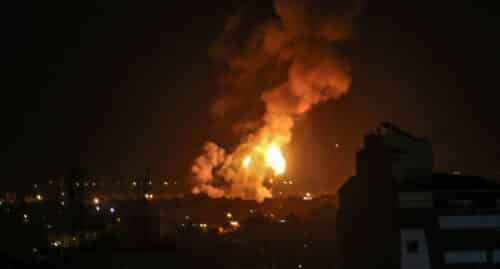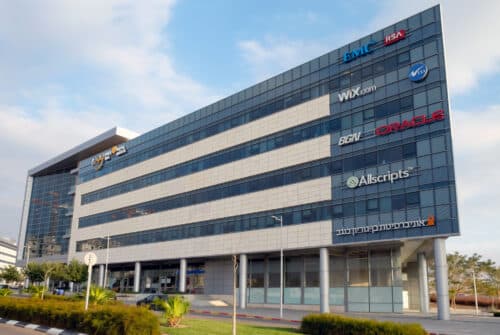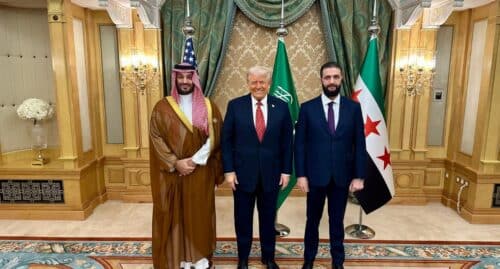The changing order in the Middle East poses significant challenges as well as opportunities to further major diplomatic and security interests
Main recommendations
- It must be impressed upon the United States that it is in its own interest – whether directly or internationally vis a vis China and Russia – to adopt a more resolute and hardline policy in the Middle East, particularly with toward Iran and its proxies. Any “understandings” between the US and Iran regarding the latter’s nuclear program are dangerous as they intensify the problematic elements of the emerging architecture in the region.
- Israel must impress upon the region’s pragmatic Arab states the advantages of collaborating with it – on the economic and technological level as well as on the diplomatic and military level.
- Israel must continue bolstering its deterrence capabilities towards Iran’s proxies, particularly in light of the possibility of Iran breaking out to a nuclear weapon. The close diplomatic and military collaboration with the American administration, joint exercises with the US military and additional partners, alongside ongoing strikes in Syria and continued counterterrorist activity in the Palestinian territories – have long been serving this purpose.
A new regional order
Since the Biden administration took office, and even more so in the past year, the architecture that governed the Middle East for decades has been undergoing dramatic shift. As of yet these changes are still in the making and may still be reversable, but already the implications for Israel are far reaching.
Until late 2020, the Middle East was shaped by the tensions among four contenders over the hegemony in the region, each with a different affinity to the West. The pragmatic Sunni bloc – led by Sadia Arabia and the UAE – relied heavily on the US and rivaled the Iranian-led radical Shi’it axis, which is hostile to the West. It also contended with a more sophisticated radical Sunni bloc led by Qatar, Turkey and the Muslim Brotherhood – also characterized by deep, albeit cautious, enmity toward the West, and lastly – the Ultra-radical Sunni faction lead by ISIS, which engaged in direct conflict with the West.
America’s approach to this regional structure had been a bone of contention in its political system, with the exclusion of the consensus around the need to wage war on ISIS, which ultimately led to the organization’s expulsion from its self-proclaimed state and to the decline of the threat it posed. Under the Obama administration, Washington adopted a policy that strived for a balance among all rival factions, avoiding confrontation with the Shi’ite bloc and collaborating with the sophisticated radical Sunni faction, while at the same time unwilling to collaborate with the pragmatic Sunnis. The jewel in the crown of this administration’s Middle East policy was its nuclear agreement with Iran. The Trump administration, however, placed its bet on closer relations with the pragmatic Sunni states and Israel, withdrawing from the nuclear agreement and helping to orchestrate the Abraham Accords.
With the Biden administration, the US again pulled back from the pragmatic states – in particular from the Saudi leadership – and despite the administration’s promise that it would prevent Iran from achieving nuclear weapons, it chose to manifest this stand by sitting at the negotiation table with a weak position regarding the future of Iran’s nuclear program, thereby in effect encouraging the regime to repeatedly violate restrictions without any repercussion on part of the US (not to mention the EU).
The US’s disinterest, which manifested among others in its rushed and embarrassing withdrawal from Afghanistan, was worrisome for the pragmatic states, mainly Saudia Arabia, as it galvanized US’s rivals for hegemony and leadership in the world order, China and Russia, to intensify their efforts toward what they deem as crucial interests (Taiwan and Ukraine) and step into the void left by the US in the Middle East. Yet while efforts to effect change in the world order were met with difficulties – mainly the inaptitude of the Russian army and the Ukrainian resoluteness, and the impressive Western support for the latter, the Middle East was not as eager to stand with the natural allies of the West and this – among additional developments discussed further in this article – set the stage for the shift in the regional architecture.
The predominant manifestations of the new regional order are:
- The easing of tensions among the rival factions, especially among the pragmatic and radical Shi’ite blocs, culminating with the agreement on part of Iran and Saudia Arabia on the renewal of relations between the two countries. Furthermore, relations were reestablished between the pragmatic bloc countries and Iran’s protégé – Syria. Qatar and Turkey followed suit and curried favor with the pragmatic bloc. This shift had begun towards the end of the Trump administration, and with his encouragement, and continued into the Biden administration. However, it should be mentioned that these shifts did not lead to any abolishment of the region’s factions and the factions and axes continue in their past form, as well as their inherent ideological differences, which were not reconciled. The significance of this is that a shift in these relations may lead to a reversal of the traditional status quo.
- The rise in Iran’s status in the region and beyond: Iran is tightening its relations with international power players, China and Russia, which like Iran, are challenging the Western world order. For this end, Iran is leveraging its supply of arms, and in particular attack drones, to Russia, for use in its Ukraine campaign. Iranian officials are conducting talks with elements that were considered rivals not long ago, and hold visits to countries which until recently were considered hostile to the regime. The pinnacle of this shift is President Raisi’s expected visit to Saudia Arabia (the date of which is yet to be determined). Here too, it is worth mentioning that in tandem with Iran’s rising status in the regional and international arenas, the country is still dealing with internal challenges of economic strife and widespread – albeit waning – popular protests sparked by the death of Mahsa Amini.
- Growing confidence on part of Iran and its proxies – primarily the Hezbollah – which are testing how far they can push the nuclear limits and their freedom of movement vis a vis the US and Israel. This is seen predominantly in Iran’s recent efforts that are bringing it to the threshold of a nuclear capabilities. Among theses activities are the unveiling of the Khorramshahr 4 missile, which can carry a nuclear warhead to distances of up to 2,000 kilometers (1,240 miles); the announcement on the successful development of a hypersonic missile – the “Fatah”; the production of metallic uranium at high enrichment levels (20% and %60) in quantities that allow it to produce enough fissile matter for over 5 nuclear weapons within approximately three months; the expansion of its enrichment capabilities with advanced centrifuges; and the relocation of nuclear facilities to deep underground sites in order to allow for better protection from air strikes. At the same time, the Iranians, as mentioned earlier, aretesting the US – just recently they’ve apprehended two American oil tankers in the Persian Gulf, attacked American targets in Syria using proxy militias, and the Hezbollah is positioning itself to join the campaign against US forces in Syria as well. In the Israeli arena, alongside Iran’s repeated threats, are most prominent Iran’s transformation of merchant vessels into floating military bases with the aim of establishing maritime presence far from Iranian shores – including in the Mediterranean Sea; the terrorist attack in Megido – a short distance from the Lebanese border, in which Hezbollah was involved; the launching of UAVs and drones into Israeli territory; the Lebanon’s mock military exercise simulating a takeover of territories and towns in Israel’s northern region of the Galilee; firing of rockets at Israel by Palestinian militants from south Lebanon, and last but not least – the rockets launched from Gaza by the Islamic Jihad that was retaliated with Israel’s Operation Shield and Arrow.
- A decline in the pragmatic state’s reliance on US security aid, manifested in the UAE’s decision to terminate its membership of the US-led task force protecting ships in the Persian Gulf.
- The growing involvement in the region on part of China, which is stepping up to take America’s place in the region. Among the most prominent manifestations of this shift are Beijing’s successful mediation in the reconciliation between Saudia Arabia and Iran, and the strategic partnership between China and the Palestinian Authority following Chairman Mahmoud Abbas (Abu Mazen)’s recent visit to the capital. This change was demonstrated in the cold reception President Biden received in his visit to the Saudi Kingdom in June 2022 as oppose to the efforts made by the Saudis to display their friendship towards China’s leader Xi, when he visited the Kingdom in December 2022.
- The relegation of the Abraham Accord from a shaping factor of the region’s architecture to a secondary status: Initially the Biden administration, which initially supported the Accords but was not enthusiastic about joining Israel’s efforts to promote them, has lately been exhibiting a more positive attitude on cementing and expanding the Accords to include Saudia Arabia. However, the terms each party puts forth as conditions for this move diminish it likelihood.
Motivation for change
The central motivation for the pragmatic states’ change of policy is their desire to hedge the risks to their security and economic prosperity. For decades, these countries relied nearly exclusively on the West for this matter. It is true that they often approached China and Russia to obtain arms that the West refused to provide, and Saudia Arabia went as far as to prepare itself for the possibility of acquiring nuclear weapons from Pakistan, yet this was done to an extent that did not diminish their reliance on the US. A list of American administrations – particularly Democratic and especially the Obama administration – caused the Saudis to begin questioning the logic of upholding this diplomatic reliance. Finally, it was the Biden administration that set the change of course in motion, for various reasons:
- Concerns that in light of Iran’s advancing nuclear program and America’s irresolution and weakness in general and in its dealings with Iran in particular, Iran will decide in the near future to break out to a nuclear weapon. On the part of the pragmatic countries, especially Saudia Arabia, there are a number of possible scenarios – none of which could play out in their favor. If Iran’s decision to produce a nuclear weapon faces no significant objections, Iran will become a superpower – at least on a regional level – in which case, Saudia Arabia and its cohorts are better off fostering good relations with Tehran, and avoiding confrontations with the regime. In the event that a breakout to a nuclear weapon is met with a military strike against its nuclear infrastructure by either Israel or the US or both, the Arab Gulf states would prefer not to be accused of collaboration with the two and thus become a target for repercussions on part of Iran – as it had threatened to do. If the US reaches understandings with Iran such that will normalize Iran’s current status and allow it to become a de facto nuclear threshold state in return for lifting a significant number of the current sanctions against Tehran – Iran will be able to upscale its capabilities thereby demonstrating yet again America’s wanning strategic status in the Middle East.
- Furthermore, the Saudis hope that the very tightening of relations with Iran at this point would create another buffering measure for Iran’s decision to break out to a nuclear weapon. In itself, this is a consideration with limited efficacy, but in the matrix of Iran considerations, whatever they might be, it may nonetheless prove to be significant.
- In a shorter-term consideration, closer relations with Iran could serve to hold back the threat from the Houthis from Yemen and Iran itself – a threat demonstrated in their strike against the Saudi oil facilities in September 2019. The price of reconciling with Assad is for the most part inconsequential as the pragmatic states have long come to realize that chances of toppling his regime with help from the moderate insurgents are close to nil, and they have no interest in backing the ultra-radical Sunnis, which constitute the core of Syria’s current opposition. Furthermore, they believe and hope that cooperation with Assad may play a role in the elimination of the Captagon drug smuggling from Syria into their territories and create to channel for negotiations in which the moderate Syrian opposition has a voice as well.
- Above all aforesaid, warm relations with Iran and China could serve as a leverage with which to signal Washington that it needs to change its policy on Saudia Arabia and the pragmatic bloc before it is too late. Saudia Arabia is not aiming to sever its special relations with the US, however, it does expect more significant measures from the latter in regards to Iran – such as sanctions and a clear and credible message of its willingness to resort to a military option if Iran continues to build up its ability break out to a nuclear weapon – and in regards to Saudia Arabia, in the form of arms supply, support for the Kingdom’s civilian nuclear program with restricted oversight, a defense agreement committing the US to assist in the defense of the country and economic investments – all in return for distancing itself from Iran and China. In any event, although tensions between Riyadh and Tehran have not eased, and the two governments still represent rival world views within the Muslim world, it is likely that at least in the short-term, Saudia Arabia will stick to a more diversified and conciliatory foreign policy.
- The State of Israel also plays a part in the emerging regional order. The indecisiveness displayed by Israel with the Hezbollah as part of the gas agreement, due to its desire to avoid confrontation with the organization, and its lack of a strong response in a series of later events, have hurt Israel’s image of military prowess and forcible deterrence. Israel’s internal crisis and tits discord with the US and the West on various issues play their role in diminishing its image as a military power. Although Israel is still perceived as strong and its actions against Iran in Syria and against Iranian proxies in Gaza ( i.e. Operation Shield and Arrow against the Palestinian Islamic Jihad) mitigate this decline, still – in the current state of affairs the pragmatic states are less inclined to rely on Israel, and opt instead to assuage tensions with Tehran.
Implications for Israel and the region
The emerging regional order, alongside the ongoing jostling over dominance in the world order, has far reaching implications on Israel’s diplomatic and security standing. Firstly, it might foster a sense of confidence and omnipotence in Tehran, which could propel the regime to decide to break out to a nuclear weapon, with all its ramifications. The more Iran comes to believe that US’ status in the Middle East is growing weaker, and Washington is disinclined to enter any confrontation with the regime – the more it might lean towards breaking out to military nuclear capabilities. This would be further accelerated if the Iran leadership comes to the conclusion that the Biden administration is likely to be replaced by a more resolute administration that is more willing to take decisive steps to ensure Iran’s nuclear program is kept at bay.
As mentioned, closer relations with Riad could serve as a buffering measure for these processes, but not so much as they can be a game changer. The Iranians might come to the conclusion that it now has the optimal conditions for breakout, among others because it is now clear that neither China nor Russia have any intention of joining the West in leaning on Iran to hit the breaks on its race to a nuclear weapon, and in the meantime, Iran is setting the stage for this contingency. The implications for Israel are more than clear: it might come to the point where it will have no choice but to launch a military strike that could exact a steep price on its home front and lead to rising tensions with the US and Western countries, otherwise – it would have to accept a dangerous reality of a nuclear Iran.
Additionally, in light of the growing understanding in the corridors of power in Washington that the chances of Iran breaking out to a nuclear weapon are rising, and taking into account its reluctance to enter any confrontation with the regime, America is becoming increasingly partial to reaching understandings with Teheran, nearly at any cost. If indeed such understandings are reached, the new order will be consolidated and the discord between Israel and the US on the Iranian nuclear issue will become even more evident, at a time of tense relations between the leaderships of the two countries. This would undoubtedly project negatively on Israel status and military image.
Secondly, the new regional order will hinder the implementation and expansion of the Abraham Accords. The price the Saudis are demanding from Israel and the US – and subsequentially America’s demands from Israel – are becoming increasingly steep as far as Israel is concerned. This is in addition to the Kingdom’s demands for an American-Saudi defense agreement and leeway for its own extensive nuclear program, whereas both parties are demanding Israel take measure on the Palestinian issue. At present, the agreements that were signed are in not yet jeopardy, but the enthusiasm and momentum characterizing the relations between both countries in the wake of the agreement is somewhat cooling off due to the reshuffling of the order in the Middle East and concerns regarding the composition of the new Israeli government. However, even in the current state of affairs, there is some rationale on Saudia Arabia’s part in furthering normalization of relations with Israel and tightening relations with the US as a means with which to reenforce its defense system and ensure the stability and prosperity of the Kingdom. This however, will not come at the expense of its newly formed relations with Iran and China.
Thirdly, Israel image of military prowess has been tarnished by the weakening status of its close ally as well as its own hesitance in dealing with the Hezbollah, and growing concerns that Iranian proxies will continue to challenge the country, as the Hezbollah has been doing lately. It is possible that Israel’s resolute response to the Islamic Jihad in Operation Shield and Arrow has counterbalanced to an extent the decline in Israel’s military image.
What can and should be done
The understanding of the problematic implications of this new reality demands that Israel take expedient and decisive steps to neutralize them. Its top priority is to get the US to see that it is in its own best interests – both direct and in regard to the rising status of China and Russia – to adopt a more decisive and resolute policy in the Middle East, particularly with Iran and its proxies. This includes steeling its willingness to resort to military measures with Iran if necessary. At this juncture in time, this may seem a high hurdle to jump but it is not impossible since the Biden administration is already focused on reaching an interim agreement with Tehran that would decelerate its nuclear program, in return for significant concessions that will enable Iran to deal with its internal challenges and consolidate its status in the region, while still maintaining its ability to produce fissile material and break out to a nuclear weapon.
This policy should include concession for the Saudi Kingdom and Gulf countries, in return for their commitment not to tighten relations with Iran and its proxies and China, and without preconditions of impossible concessions for the Palestinians on part of Israel.
Furthermore, Israel must impress upon the pragmatic Arab states, Saudia Arabia included, the advantages of economic and technological as well as diplomatic and security collaboration with Israel, exactly as it had done in the wake of the signing of the agreements. This must take into consideration the sensitivity of these countries to the Palestinian issue.
Finally, Israel must continue building up its deterrence towards Iran’s proxies and for the eventuality that Iran decides to break out to a nuclear weapon. The close diplomatic and military cooperation with the American administration, the joint exercise with the US military along with additional partners that included simulations of attacks in Iran, continued strikes in Syria and continued efforts to counter Palestinian terrorism – all serve this purpose in the long-run, even if they might not necessary lead to the immediate reversal of the problematic shifts in the region.
The views expressed in this article are those of the author and do not necessarily represent the views of the movement.





